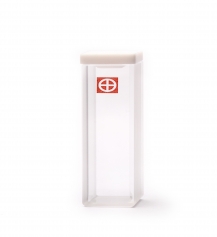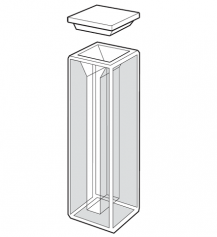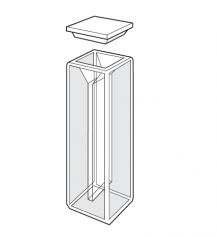UV cuvette and accessories
Product Listing
-
Description:
Glass filters mounted ‘stress free’ in an anodised aluminium Glass filter containing didymium (a mixture of neodymium & praseodymium) oxide, mounted stress free in an anodised aluminium holder. As a solid material the didymium glass filteris physically more robust than the equivalent liquid cell, and can therefore be used in more demanding environments, making it especially useful as a routine wavelength check. Sliding window covers are provided to protect the surface from damage when not in use. Variations from melt to melt of the glass can cause small uncertainties in peak position Each filter is individually certified. Approximate peak wavelength values (in nm) are: 431, 473, 513, 529, 573, 585, 685, 741, 749, 807, 879. Material Part Number Wavelength range Usage Didymium 226-85009-01 430 nm to 890 nm For wavelength analysis Holmium Oxide 226-85009-02 240 nm to 640 nm For wavelength analysis Didymium Oxide/Neutral Density 226-85009-21 430 nm to 890 nm For wavelength and absorbance analysis Holmium Oxide/Neutral Density 226-85009-22 360 nm to 640 nm For wavelength and absorbance analysis
OUT OF STOCKGlass filters mounted ‘stress free’ in an anodised aluminium Glass filter containing didymium (a mixture of neodymium & praseodymium) oxide, mounted stress free in an anodised aluminium holder. As a solid material the didymium glass filteris physically more robust than the equivalent liquid cell, and can therefore be used in more demanding environments, making it especially useful as a routine wavelength check. Sliding window covers are provided to protect the surface from damage when not in use. Variations from melt to melt of the glass can cause small uncertainties in peak position Each filter is individually certified. Approximate peak wavelength values (in nm) are: 431, 473, 513, 529, 573, 585, 685, 741, 749, 807, 879. Material Part Number Wavelength range Usage Didymium 226-85009-01 430 nm to 890 nm For wavelength analysis Holmium Oxide 226-85009-02 240 nm to 640 nm For wavelength analysis Didymium Oxide/Neutral Density 226-85009-21 430 nm to 890 nm For wavelength and absorbance analysis Holmium Oxide/Neutral Density 226-85009-22 360 nm to 640 nm For wavelength and absorbance analysis
-
Description:
Glass filter containing holmium oxide, mounted stressfree in an anodised aluminium holder. As a solid material the holmium glass filter is physically more robust than the equivalent liquid cell, and can therefore be used in more demanding environments, making it especially useful as a routine wavelength check. Sliding window covers are provided to protect the surface from damage when not in use. Variations from melt to melt of the glass can causesmall uncertainties in peak position Each filter is individually certified. Approximate peak wavelength values (in nm) are: 242, 279, 288, 334, 361, 419, 446, 454, 460, 537, 638 Material Part Number Wavelength range Usage Didymium 226-85009-01 430 nm to 890 nm For wavelength analysis Holmium Oxide 226-85009-02 240 nm to 640 nm For wavelength analysis Didymium Oxide/Neutral Density 226-85009-21 430 nm to 890 nm For wavelength and absorbance analysis Holmium Oxide/Neutral Density 226-85009-22 360 nm to 640 nm For wavelength and absorbance analysis
OUT OF STOCKGlass filter containing holmium oxide, mounted stressfree in an anodised aluminium holder. As a solid material the holmium glass filter is physically more robust than the equivalent liquid cell, and can therefore be used in more demanding environments, making it especially useful as a routine wavelength check. Sliding window covers are provided to protect the surface from damage when not in use. Variations from melt to melt of the glass can causesmall uncertainties in peak position Each filter is individually certified. Approximate peak wavelength values (in nm) are: 242, 279, 288, 334, 361, 419, 446, 454, 460, 537, 638 Material Part Number Wavelength range Usage Didymium 226-85009-01 430 nm to 890 nm For wavelength analysis Holmium Oxide 226-85009-02 240 nm to 640 nm For wavelength analysis Didymium Oxide/Neutral Density 226-85009-21 430 nm to 890 nm For wavelength and absorbance analysis Holmium Oxide/Neutral Density 226-85009-22 360 nm to 640 nm For wavelength and absorbance analysis
-
Description:
Glass filter containing didymium (a mixture of neodymium & praseodymium) oxide, optically bonded to a neutral density filter and mounted stress free in an anodised aluminium holder. Sliding window covers are provided to protect the surface from damage when not in use. Variations from melt to melt of the glass can cause small uncertainties in peak position. Each filter is individually certified. 9 peak wavelengths are certified at nominal values of 473, 514, 530, 572, 586, 739, 748, 807 and 879 nm. The absorbance values, nominally 1A, are certified at wavelengths between the didymium peaks, at 410, 455, 550, 637 and 773 nm. Material Part Number Wavelength range Usage Didymium 226-85009-01 430 nm to 890 nm For wavelength analysis Holmium Oxide 226-85009-02 240 nm to 640 nm For wavelength analysis Didymium Oxide/Neutral Density 226-85009-21 430 nm to 890 nm For wavelength and absorbance analysis Holmium Oxide/Neutral Density 226-85009-22 360 nm to 640 nm For wavelength and absorbance analysis
OUT OF STOCKGlass filter containing didymium (a mixture of neodymium & praseodymium) oxide, optically bonded to a neutral density filter and mounted stress free in an anodised aluminium holder. Sliding window covers are provided to protect the surface from damage when not in use. Variations from melt to melt of the glass can cause small uncertainties in peak position. Each filter is individually certified. 9 peak wavelengths are certified at nominal values of 473, 514, 530, 572, 586, 739, 748, 807 and 879 nm. The absorbance values, nominally 1A, are certified at wavelengths between the didymium peaks, at 410, 455, 550, 637 and 773 nm. Material Part Number Wavelength range Usage Didymium 226-85009-01 430 nm to 890 nm For wavelength analysis Holmium Oxide 226-85009-02 240 nm to 640 nm For wavelength analysis Didymium Oxide/Neutral Density 226-85009-21 430 nm to 890 nm For wavelength and absorbance analysis Holmium Oxide/Neutral Density 226-85009-22 360 nm to 640 nm For wavelength and absorbance analysis
-
Description:
Glass filter containing holmium oxide, bonded to a neutral density filter and mounted stress free in an anodised aluminium holder. Sliding window covers are provided to protect the surface from damage when not in use. Variations from melt to melt of the glass can cause small uncertainties in peak position. Each filter is individually certified. 7 peak wavelengths are certified at nominal values of 361, 419, 446, 454, 460, 537 and 638 nm. The absorbance values, nominally 1A, are certified at wavelengths between the holmium peaks, at 431, 516, 557, 594 and 623 nm. Material Part Number Wavelength range Usage Didymium 226-85009-01 430 nm to 890 nm For wavelength analysis Holmium Oxide 226-85009-02 240 nm to 640 nm For wavelength analysis Didymium Oxide/Neutral Density 226-85009-21 430 nm to 890 nm For wavelength and absorbance analysis Holmium Oxide/Neutral Density 226-85009-22 360 nm to 640 nm For wavelength and absorbance analysis
OUT OF STOCKGlass filter containing holmium oxide, bonded to a neutral density filter and mounted stress free in an anodised aluminium holder. Sliding window covers are provided to protect the surface from damage when not in use. Variations from melt to melt of the glass can cause small uncertainties in peak position. Each filter is individually certified. 7 peak wavelengths are certified at nominal values of 361, 419, 446, 454, 460, 537 and 638 nm. The absorbance values, nominally 1A, are certified at wavelengths between the holmium peaks, at 431, 516, 557, 594 and 623 nm. Material Part Number Wavelength range Usage Didymium 226-85009-01 430 nm to 890 nm For wavelength analysis Holmium Oxide 226-85009-02 240 nm to 640 nm For wavelength analysis Didymium Oxide/Neutral Density 226-85009-21 430 nm to 890 nm For wavelength and absorbance analysis Holmium Oxide/Neutral Density 226-85009-22 360 nm to 640 nm For wavelength and absorbance analysis
-
-
-
-
-
High-Quality UV-Vis Cuvettes in Singapore
A Ultraviolet-Visible (UV-Vis) spectrophotometer is used in spectroscopy analysis to help in determining absorbance or transmittance of discrete wavelengths (UV or visible light radiation) through the sample. A UV-Vis cuvette is also necessary to hold the sample needed by the UV-Vis spectrophotometer during the analysis.
The choice of cuvette depends on your application. Using an appropriate UV-Vis cuvette is required for your analysis to get an accurate measurement of your sample. There are different types of UV-Vis cuvette cells made mainly from quartz and glass materials. Our cuvettes are available in different path lengths, including standard 10 mm and microvolume options, providing flexibility for sample volumes and concentration ranges. Whether you're working with small sample volumes or need high-throughput capabilities, we have the perfect UV cuvette to suit your needs. Micro and semi-micro cuvettes are also available for analysis of small sample volumes.
Should you need UV-Vis cuvettes of any kind, you can purchase them all at ShopShimadzu. You can also browse our UV-Vis consumables to see our full range of cuvettes and accessories.
ShopShimadzu UV-Vis Cuvettes: Precision in Spectrophotometry
Spectroscopy plays an important role in many areas of science, which includes quality control in the beverage industry and many more. It is a key process that enables businesses to learn more about the sample composition and concentration of their products or samples.
Getting a reliable and good-quality UV-Vis cuvette ensures that you can carry out your spectrophotometric analysis without worrying about the sample being contaminated during the process. We are your one-stop shop for you to get all your UV-Vis cuvettes and accessories anytime, anywhere.
ShopShimadzu is a supplier based in Singapore that offers low-end to high-end quality UV-Vis cuvettes to help you with different types of analysis. Our cuvettes are manufactured using premium-grade materials, ensuring excellent chemical resistance and optical transparency. This guarantees minimal interference and precise transmission of light, enabling you to obtain reliable and reproducible results.
Our UV-Vis cuvettes come with advanced optical properties, making them ideal for a wide range of applications. They offer exceptional light transmission across the UV and visible spectra, allowing for precise measurements of absorbance and transmittance. The cuvettes exhibit low stray light levels, ensuring accurate readings even at the lowest concentrations. This outstanding performance is crucial for demanding analytical techniques, such as DNA/RNA quantification, protein analysis, enzyme kinetics, and more.
We have designed our cuvettes to fit seamlessly into the most popular spectrophotometer models, ensuring hassle-free integration into your laboratory workflow. Additionally, they are compatible with a wide range of sample solutions, including aqueous and organic solvents, acids, bases, and more. With this versatility, you can conduct experiments across diverse research areas with ease.
Browse through our catalogue of UV-Vis cuvettes, including standard cells (quartz cuvette and glass cuvette), fluorescence cells, flow cells, cylindrical cells, and more by purchasing them online on our website. Register with us today and get all the laboratory consumables you need, including HPLC columns, GC columns, and sample vials.
Frequently Asked Questions About UV-Vis Cuvettes
1. What is the difference between UV-Vis glass and quartz cuvettes?
Glass cuvettes are transparent to visible light and are therefore used for measurement in the visible light range (320 to 2500 nm). They are, however, not suitable for analysis in the UV range (200 to 320 nm) as they absorb UV light.
If your analysis uses wavelengths in the UV range, you would need to use a quartz cuvette. Quartz cuvettes are transparent in both UV and visible light ranges (200 to 2500 nm). They can therefore be used for analysis in both UV and visible light ranges.
Are you looking for a quartz or glass cuvette for your spectrophotometry measurements? We supply both glass and quartz cells in various dimensions and light paths, including our standard cells, fluorescence cells, microcells, semi-micro cells, flow cells, and more, for application in UV-Vis and fluorescence spectroscopy.
2. Can I use a UV-Vis cuvette for fluorescence analysis?
No, you should never use a UV-Vis cuvette for fluorescence spectroscopy. Although the material used for UV-Vis cuvettes and fluorescence cuvettes are similar, the number of polished sides for the two cuvettes is different. In fluorescence spectroscopy, the detector is perpendicular to the light source. Therefore, it requires all four windows to be polished, whereas UV-Vis cuvettes only have two polished sides.
















